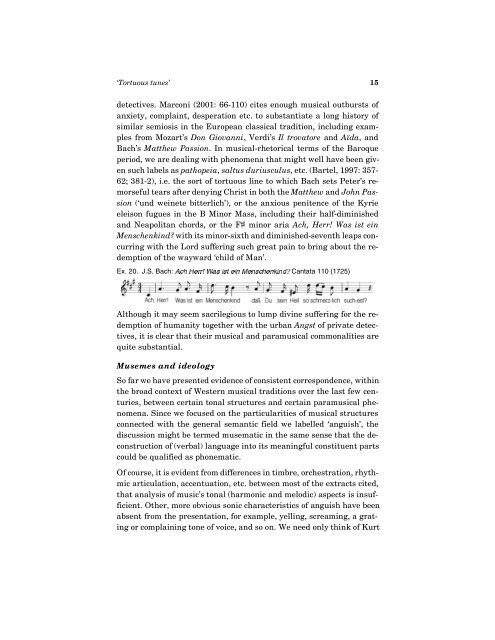You also want an ePaper? Increase the reach of your titles
YUMPU automatically turns print PDFs into web optimized ePapers that Google loves.
‘Tortuous tunes’ 15<br />
detectives. Marconi (2001: 66-110) cites enough musical outbursts of<br />
anxiety, complaint, desperation etc. to substantiate a long history of<br />
similar semiosis in the European classical tradition, including examples<br />
from Mozart’s Don Giovanni, Verdi’s Il trovatore and Aïda, and<br />
Bach’s Matthew Passion. In musical-rhetorical terms of the Baroque<br />
period, we are dealing with phenomena that might well have been given<br />
such labels as pathopeia, saltus duriusculus, etc. (Bartel, 1997: 357-<br />
62; 381-2), i.e. the sort of tortuous line to which Bach sets Peter’s remorseful<br />
tears after denying Christ in both the Matthew and John Passion<br />
(‘und weinete bitterlich’), or the anxious penitence of the Kyrie<br />
eleison fugues in the B Minor Mass, including their half-diminished<br />
and Neapolitan chords, or the F# minor aria Ach, Herr! Was ist ein<br />
Menschenkind? with its minor-sixth and diminished-seventh leaps concurring<br />
with the Lord suffering such great pain to bring about the redemption<br />
of the wayward ‘child of Man’.<br />
Ex. 20. J.S. Bach: Ach Herr! Was ist ein Menschenkind? Cantata 110 (1725)<br />
Although it may seem sacrilegious to lump divine suffering for the redemption<br />
of humanity together with the urban Angst of private detectives,<br />
it is clear that their musical and paramusical commonalities are<br />
quite substantial.<br />
Musemes and ideology<br />
So far we have presented evidence of consistent correspondence, within<br />
the broad context of Western musical traditions over the last few centuries,<br />
between certain tonal structures and certain paramusical phenomena.<br />
Since we focused on the particularities of musical structures<br />
connected with the general semantic field we labelled ‘anguish’, the<br />
discussion might be termed musematic in the same sense that the deconstruction<br />
of (verbal) language into its meaningful constituent parts<br />
could be qualified as phonematic.<br />
Of course, it is evident from differences in timbre, orchestration, rhythmic<br />
articulation, accentuation, etc. between most of the extracts cited,<br />
that analysis of music’s tonal (harmonic and melodic) aspects is insufficient.<br />
Other, more obvious sonic characteristics of anguish have been<br />
absent from the presentation, for example, yelling, screaming, a grating<br />
or complaining tone of voice, and so on. We need only think of Kurt














